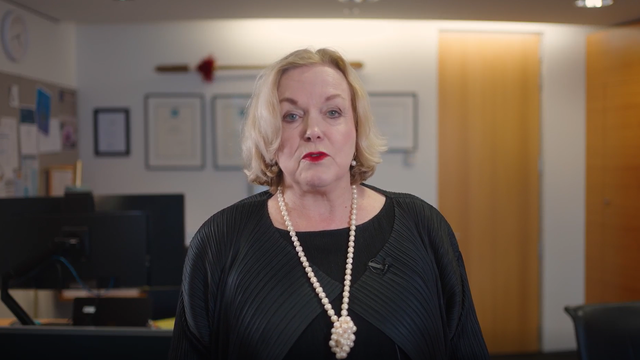

Shared Services and Priorities
Government services are made up of different departments and agencies all working towards a common cause. Many of the institutions often feel siloed and independent, yet as Paul Glover, the President of Shared Services Canada says, any service that you interact with in the federal government, if it's digital in some way, then Shared Services Canada (SSC) has something to do with it. They make government services run and in the process, link many of the departments and agencies. We essentially provide IT and technology-based services to all federal departments and agencies. This includes networks, hardware and software. The individual departments still run their own applications, but SSC has the overriding responsibility for all the services. This is a huge operation that has a recurring spend of about $3 billion annually, though this year that will be even greater.
The current program is called SSC 3.0, though in part that is because I’m the third President. The organization was created about a decade ago. The founding President created it and convinced the government that it was necessary. The second President had to prove we could make it work, and now in its third iteration it is about embedding the enterprise approach, putting the ‘shared’ back into shared services. In terms of priorities, this means making everything that the SSC does more reliable and more modern, but also more user-centric in terms of behaviour. For a while now, the approach was all about speed. Start small, fail fast, learn from it, lock it in and build it into a playbook to scale it up. Service standards also matter and need to be built in.
Until COVID-19 came long, these were the priorities and main objectives of SSC. They were well received and people thought that they were the right things for us to be focusing on. Despite that, some people and even departments didn’t quite understand the difference between a service organization and a shared service organization. The difference is fundamental. A service organization is about customization and attending to every need. A shared service organization on the other hand is about focusing not on the uniqueness, but on the commonness, and building up common platforms. Organizations need to understand why they’re unique, but also their commonalities and need to be able to work together. This is a maturing that is still happening.
Impacts From the Pandemic
Before the pandemic, the network that SSC built was designed for remote work and for scaling up, but COVID-19 accelerated that through the roof. The network – spread across all agencies of the federal government – was designed to have about 30,000 people working from home at any one time. In a matter of days, there were close to 400,000 people working from home, and we had to make that happen. Conference calls were always popular in government, and before the pandemic, the network was handling a million minutes a day. Almost immediately that went up to 5 to 6 million minutes a day, every day. Previously the government operated almost 100 call centres with different peak volumes. Now the volumes are just consistently astronomical, with some people taking calls in bedrooms or on cell phones. We set up the tools for that and all our call centres are now virtual. SSC also increased the bandwidth, set up video conferencing platforms as well as MS Office 365 and Teams. In a matter of days, we had a couple of hundred thousand people using all the new platforms.
“We took a three year roll out plan and did it in about five weeks, all done and fully on-boarded. It was truly remarkable. But it wasn’t the Prime Minister or an internal policy priority that pushed us. It was COVID-19 and happened as a result of a necessity. Luckily we already had a plan and a framework and were able to accelerate it. We knew what we had to do, but without a doubt, COVID-19 was the major accelerator.” - Paul Glover, President, Shared Services Canada
In many ways the pandemic achieved what no policy could, and though the circumstances weren’t ideal, it taught us that speed and scale matter. It also taught us to approach risk differently. Risks previously were essentially in two categories: cost and schedule risks. This worked when things were going at a normal pace and under pre-COVID conditions, but now things have changed. Now we have to consider execution and delivery risks. When things are running at a phenomenal pace, these risks become important. When we started to recalibrate our approaches relative to the new risks we were seeing, we found we were able to behave very differently. That’s why SSC was able to respond at pace. Usually there’s time to over plan and over budget, but in the circumstances of the pandemic, it was all about execution because there was a much higher cost in not having a service.
One of the major things that the pandemic has shown is that technology is only getting better and better. It would be hard to imagine that an entire federal government could have responded in the way Canada did just a few years earlier. The platforms and ideas that were just a dream a few years ago are all becoming realities fast, and are finally getting close to the realization that they promised years ago. IT providers now have the technologies that large-scale companies use and need at their fingertips. In terms of IT and digitization, this will forever change the way governments operate. There is now confidence in the industry that the skills and processes can work because they did work. There is an understanding about how to do this at a level we haven’t had before.
In many ways this is likely to extend to how people work in the future. Remote work is here to stay. It won’t be 100% remote as it was during the height of the pandemic, but there will be a mix of people working fully or partly at home. This will influence how we design our office spaces and what tools we give our employees. In many ways, the challenge is cultural not technological.
“Ultimately the pandemic has given us what we’ve been talking about for years, which is employees and everyday citizens being able to interact with government anytime, anywhere and on any device. Employees can run a call centre from home, and can create presentations on their phones.” - Paul Glover, President, Shared Services Canada
Lessons Moving Forward
From the perspective of a shared service organization, there are a few lessons that come from the pandemic:
- We’re going to have to be strategic partners – To really move forward, vendors and government need to better develop their relationships. Their success is our success. Our success is theirs. It is important to note that there is a cost to every transition and particularly when the transformations are done at speed. Knowing who to turn to and how to respond will have to be a priority and a long-term relationship. It’s not just about having contractors fixing a problem. It’s about working together to develop strategic outcomes and build out new competencies.
- Having an enterprise approach – Although departments and agencies will continue to exist, they are no longer organizational units, they are communities of practice. A department like Health Canada for instance is about policy, but it’s also about science, regulation, inspections – different tools for different practices. We’ll be talking about personas to better meet our needs moving forward.
- Unit costs vs number of units – Over the years, unit costs have been dropping, but are being more than offset by an increase in the number of units. This means that we have to spend more time thinking about how we architect these services so that we create that increased consumption more smartly. Doing things more efficiently will become really important moving forward.
Featured speaker:
- Paul Glover, President, Shared Services Canada


































